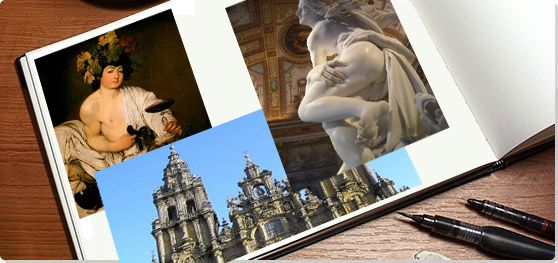Summary of Baroque Art and Architecture
In 1527 Europe, religious dominance had the power to direct and inform the content and climate of society's artistic output. At the time, a backlash against the conservative Protestant Reformation was compelled by the Catholic Church to re-establish its importance and grandeur within society. Artists followed suit by reviving Renaissance ideals of beauty, infusing into the era's artwork, music, and architecture a revived nod to classicism further enhanced by a new exuberant extravagance and penchant for the ornate. This highly embellished style was coined Baroque and became marked by its innovative techniques and details, delivering a lush new visual language into what had been a relatively toned down period for art.
Baroque disseminated throughout Europe, primarily led by the Pope in Rome and Catholic rulers in Italy, France, Spain, and Flanders. It was further disseminated by powerful religious orders through their extensive network of monasteries and convents. The style spread rapidly to France, northern Italy, Spain and Portugal, then to Austria and southern Germany.
Key Ideas & Accomplishments
- Baroque brought images for religious worship back into the public eye after being banned for their glorification of the ethereal and ideal. The movement's leaders professed that art should be easily understood and strongly felt by common people with the effect of encouraging piety and an awe for the church.
- Baroque churches became a pivotal example of the invigorated emphasis on the glory of Catholicism with their designs that incorporated a large central space with a dome or cupola high overhead, allowing light to illuminate the space below. The dome was one of the central symbolic features of baroque architecture illustrating the union between the heavens and the earth. Extremely intricate interiors, rife with ornamentation, allowed for a feeling of being fully immersed within an elevated and sacred space.
- The defining characteristics of the Baroque style were: real or implied movement, an attempt to represent infinity, an emphasis on light and its effects, and a focus on the theatrical. A number of techniques were introduced, or further developed, by Baroque artists to accomplish these effects including quadro riportato (frescos that incorporated the illusion of being composed of a series of framed paintings), quadrature (ceiling painting), and trompe l'oeil techniques. This allowed for a blurring of the boundaries between painting, sculpture, and architecture that was signature to the movement.
- Baroque ushered in a new era for European sculpture, led largely by the work of Gian Lorenzo Bernini, which emphasized sensual richness, dramatic realism, intense emotion, and movement. In Baroque sculpture figures assumed new importance, often spiraling outward from a central vortex, reaching into the surrounding space, meant to be seen in the round from multiple perspectives.
- The use of chiaroscuro, in which the treatment of light and dark in an artwork helped to create dramatic tension, was a key component in Baroque artwork. It was further evolved by Baroque master Caravaggio into tenebrism, which used the intensification of contrast within dark atmospheric scenes to spotlight particular elements.
Artworks and Artists of Baroque Art and Architecture
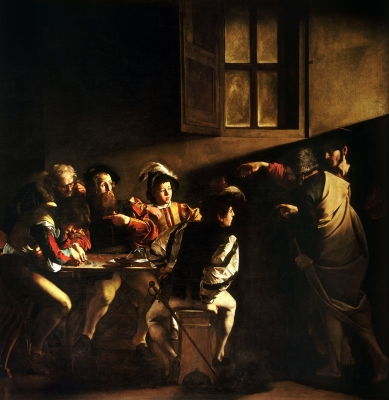
The Calling of St Matthew
This work shows a dark tavern where a number of men dressed in contemporary clothing have turned to face Christ, his right arm pointing toward St. Matthew. The light, creating a diagonal that follows Christ's gesture, highlights the expressions and gestures of the men, conveying a sense of the dramatic arrival of the divine. The figures are depicted realistically, their strong muscled calves and thighs in mid-movement. The man at the end of the table is slumped over counting coins.
This work was one of three paintings that the artist created in a commission to depict the signature moments in the life of St. Matthew. Employing chiaroscuro, the intense contrast of light and dark, the work exhibits the direct realism and intense sense of psychological drama that distinguished Caravaggio's work. His technique involved using ordinary people as models and painting them directly, leaving out the drawing stage, and, as a result, as art curator Letizia Treves said, he "made these Biblical stories so vivid, he brought them into his own time - and he involves you, so that you don't just passively watch. Even today, you don't need to know the story...to feel involved in the drama."
In the early 1600s, noted artists including Rubens, Velázquez, Rembrandt, and the Caravaggists throughout Europe were widely influenced by Caravaggio's style. He also influenced lesser-known artists like Dirck van Baburen, Gerrit van Honthorst, and Valentin de Boulogne. By the end of the century, his work fell into obscurity displaced by a rising emphasis on classicism, and wasn't revived until the mid-20th century with a major exhibit in Milan in 1951. His work has again become influential, for example, upon photographer David LaChappelle, the artist Mat Collishaw, and filmmaker Martin Scorsese. Scorsese said of his work, "You come upon the scene midway and you're immersed in it ... It was like modern staging in film: it was so powerful and direct."
Oil on canvas - San Luigi dei Francesi, Rome

Le debarquement de Marie de Médicis au port de Marseille le 3 November
This painting depicts the arrival of The Queen of France Marie de' Medici, dressed in resplendent silver, accompanied by the Grand Duchess of Tuscany and the Duchess of Mantua, as she disembarks on a red parapet. A soldier in a blue cloak patterned with gold fleur-de-lis to signify France, opens his arms to greet her. Above her, a mythological winged figure, representing Fame with two trumpets, heralds her arrival to marry King Henry IV. The diagonal of the red parapet that extends from the gold prow of the ship creates a sense of movement and it also divides the painting into two different worlds; the elegant and refined world of nobility above, and the classical mythological scene below. Three Greek Naiads, goddesses of the sea who ensured safe voyages, fill the lower frame. To their left, Neptune with a gray beard holds out his arm to calm the sea, while next to him, the god Fortune leans against the boat while steering it. These mythological figures lend grandeur and allegorical meaning to the Queen's arrival, but, at the same time, the three nude Naiads overshadow the event with their dynamic sensuality.
Rubens' masterful compositions that combined a wealth of history and allegory with depictions of signature moments in scenes of visual exuberance were much in demand with the nobility. The unabashed sensuality of his full-figured female nudes was also innovative, and so distinctive they are still dubbed as "Rubenesques." As art critic Mark Hudson wrote, "He imported the proto-baroque painting of Titian and Michelangelo and the gritty realism of Caravaggio into Northern Europe, fusing them into a physically gigantic, sensually overloaded, triumphantly Catholic art."
This was one of 24 paintings commissioned by Marie de' Medici in 1621, after the assassination of her husband Henry IV, to create a cycle to immortalize her life. She may also have been motivated to portray her rightful standing, as tensions between the ruling factions in France and a "foreign" queen had led to her banishment from the court in 1617. Rubens, the most famous painter in Northern Europe, was drawn to the commission as it gave him permission to explore a secular subject, and one that he could inform with allegorical and mythological treatments. Art historian Roger Avermaete wrote of the work, "He surrounded her [Marie de' Medici] with such a wealth of appurtenances that at every moment she was very nearly pushed into the background. Consider, for example, the Disembarkation at Marseilles, where everyone has eyes only for the voluptuous Naiads, to the disadvantage of the queen who is being received with open arms by France."
Ruben's work was influential upon artists like Velázquez and informed the Rococo artists that followed including Antoine Watteau and Francois Boucher. He also influenced Eugène Delacroix, Paul Cézanne, and Pablo Picasso. Though less known, his landscapes also influenced J.M.W. Turner, John Constable, and Thomas Gainsborough. As Mark Hudson wrote, "From Rembrandt, Watteau and Delacroix to Cézanne and Picasso, the Rubenesque sensibility runs strong and deep through Western art."
Oil on canvas - Musée du Louvre, Paris

Judith and Holofernes
This dynamic painting depicts the Biblical story of the pious widow Judith and her attendant Abra as they behead the struggling Assyrian general Holofernes. When Holofernes besieged and threatened to destroy her city, Judith adorned herself and went out to meet him on the pretext of offering information. Intending to seduce her, he invited her into his tent for dinner but as the Bible says, "was so enchanted with her that he drank far more wine than he had drunk on any other day in his life." Taking a sword, Judith beheaded him and returned with his head in a basket to the city, where she was acclaimed as a hero. Unlike traditional depictions which emphasized Judith's beauty and delicacy and portrayed Abra as an observing witness, this work innovatively emphasizes the women's strength, their expressions conveying determined resolve, as they work together, sleeves rolled up, to do a difficult but necessary task. The intense physicality and violence of the depiction, as art historian Esperança Camara wrote, "to this day...strikes its viewers with both revulsion and awe at the skill of the artist who so convincingly transformed paint into blood."
This particular subject was popular in Renaissance Florence, as seen in Donatello's statue Judith and Holofernes (1460). In the Baroque period, it became identified with the Church Militant, an expression of the victory of Christianity. But Gentileschi's portrayal took on a unique immediacy as it was informed by a personal traumatic experience. She portrayed herself as Judith and Holofernes resembles the artist Agostino Tassi, her art tutor who raped her. In 1612 he was put on trial (although it was Gentileschi who was tortured to ascertain her truthfulness), found guilty, and spent eight months in prison before being pardoned early into his sentence. Even though he had been convicted of rape previously and suspected of having murdered his wife, Tassi benefited from both the gender privileges of the era and the protection that powerful patrons extended to artists. Pope Innocent X said, "Tassi is the only one of these artists who has never disappointed me," meaning because he never pretended to be a man of honor. As art critic Jonathan Jones wrote, "she communicated a powerful personal vision," that "fought back against the male violence that dominated the world she lived in." Perhaps as a result of that intense personal vision, her work was later hidden away. By the 1700s it was viewed as 'too violent.' In her own time, as Jones wrote, "the visceral power of her paintings made her one of the most famous artists in Europe." Feminist artists, including Judy Chicago and the Guerilla Girls in the 1970s, subsequently rediscovered her work.
Oil on canvas - The Uffizi Gallery, Florence
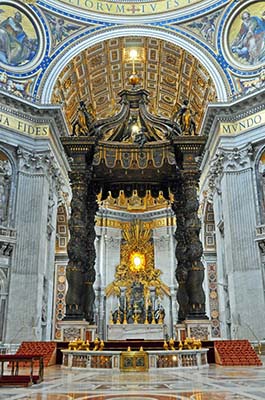
Baldachin
The Barberini family of Pope Urban VII commissioned this Baldachin, or ceremonial canopy, for the site of St. Peter's tomb in the Vatican City. It is made of four helical Solomonic columns that twist upward towards four monumental angels who gather beneath a gleaming gold cross resting on an orb in a classic symbol of the triumph of Christianity. The dynamic energy of the columns, named for the ancient Temple of Solomon, metaphorically connect the past to the present to convey the continuing authority of the church. A dramatic and awe-inspiring effect is created, towering over the high altar. Innovatively combining sculpture with architecture, the structure meditates between the vast scale of the basilica and the human scale of the gathered worshippers, while also framing and leaving open the view to the Chair of St. Peter, also designed by Bernini.
Bernini's elaboration of surfaces with symbolic details pioneered the High Baroque's emphasis on the ornate. The plinths, or marble bases, are carved in eight escutcheons, showing the Barberini coat of arms with bees, a tiara with the keys of St. Peter, a satyr's head, and a woman's head. The woman's facial expressions dramatically change and are replaced in the last plinth with the face of a cherub causing a number of scholars to have dubbed it the "childbirth sequence." Moving higher up the columns, olive and laurel motifs, small cherubs chasing bees, and an occasional lizard proliferate, creating both an organic vitality and symbolic meaning. These details are so precisely observed and realistic that a legend spread that Bernini had covered a living lizard to cast it.
In his Montage and Architecture (1940) the great filmmaker Sergei Eisenstein described the sequence as "one of the most spectacular compositions of that great master Bernini," with the coats of arms as "eight shots, eight montage sequences of a whole montage scenario."
Bronze, gilded, marble - St. Peter's Basilica, Rome
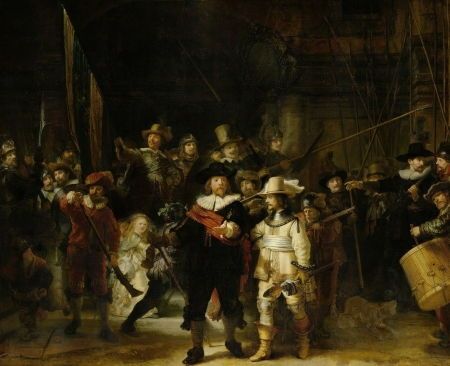
The Night Watch
This painting depicts a militia company (basically a civil guard unit) as it prepares to move out to protect the city. Employing light and shadow to center on the figure of Captain Frans Banning in black and his lieutenant Willem van Ruytenburch, wearing the shimmering yellow of victory. To the left of Banning, a single girl dressed in luminous fabric may symbolize the company. Her belt contains two clues: a pistol and the talons of a dead chicken, which represented the clauweniers, or the Dutch name for this company of harquebusiers, (men armed with long guns.) A sense of dynamic anticipation is conveyed by the facial expressions and gestures of the company: a man beats a drum on the right but no one appears to be paying attention; another man awkwardly tries to load his musket; and a man wearing a helmet with oak leaves has just fired off his own. As a result, Rembrandt captures the comedic, boisterous, purposeful, and individualistic humanity of the group.
The Militia Company of District III commissioned the group portrait in 1639, meant for exhibition in the new Kloveniersdoelen (Musketeer's Meeting Hall). Rembrandt's piece accomplished the traditional representation of every individual yet compositionally presented something new; as art critic Maaike Dirkx wrote, "Rembrandt did something very different: in his Night Watch not the sitters but the action is the focus of attention and where other civic guards paintings are static, his is all about movement."
Although in later life, Rembrandt's career went into decline and his work was generally forgotten, his work was rediscovered in the 1800s and he influenced a number of artists including Auguste Rodin, Max Liebermann, and Vincent van Gogh. Now one of the world's most recognizable paintings, this piece has enjoyed continual cultural presence evoked by philosopher Maurice Merleau-Ponty, Jean-Luc Godard's film Passion, The Night Watch (1982), and Peter Greenaway's film Nightwatching (2007).
Oil on canvas - Rijksmuseum, Amsterdam
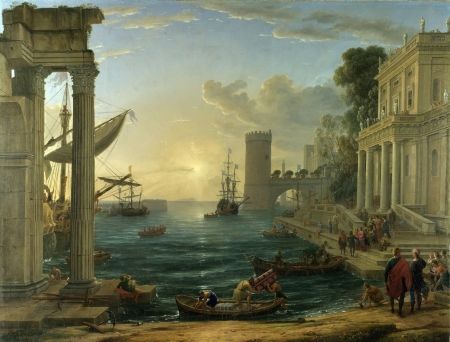
Embarkation of the Queen of Sheba
This work presents an imagined and idealized city drenched with a feeling of calm grandeur, enhanced by the work's poetic emphasis upon light. It references the biblical story of the Queen of Sheba's visit to King Solomon in Jerusalem, yet focuses primarily on the landscape with the sun and its rays vertically intersecting the canvas. Classical buildings frame both sides of the view, creating a strong sense of composition, informed by a precise linear perspective. The columns on the left mirror the ship's masthead, intersected by its diagonals of sail and prow. On the right, the columns of the building draw the viewer's attention down to the group around the Queen descending to a launch boat.
Claude innovatively chose the moment of the Queen's departure, rather than the traditional depiction of her meeting with King Solomon, allowing him to focus on a harbor scene, a subject he pioneered. His innovative explorations of light made him the most noted landscape painter of his day. Though French, he trained in Rome and subsequently, worked in the city for noted patrons, including the Duc de Bouillon, a general in the Papal army, who commissioned this work as part of a pair depicting joyful Biblical scenes. The other painting, Landscape with the Marriage of Isaac and Rebecca (1648) makes the landscape itself the subject, as the only reference to the Biblical story is a small inscription on a tree painted in the idealized pastoral.
Claude's work greatly influenced J.M.W. Turner who painted Dido Building Carthage (also known as The Rise of the Carthaginian Empire) (1815), echoing this painting. Turner felt this was so important to his oeuvre that initially his will requested he be buried wrapped in the canvas. He later amended his will to request that the painting be shown, paired with his Sun Rising through Vapour, Fishermen Cleaning and Selling Fish (1807), along with Claude's pair of paintings.
Oil on canvas - The National Gallery, London
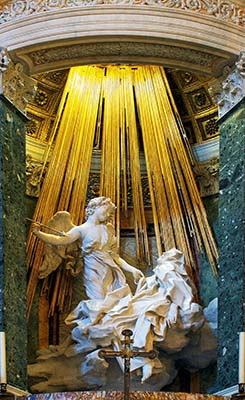
Ecstasy of Saint Teresa
The colorful interior of Bernini's Cornaro Chapel located in the Santa Maria della Vittoria Church is highly embellished. Within it on the right, we see a statue of St. Teresa in a state of ecstasy. Above her on the left, a male angel smiles down upon her, holding the spear that he will plunge into her heart. The marble seems to swirl and fall emphasizing Teresa's swoon as the sculpture is lit from a ray of golden light from above.
St. Teresa of Avila was canonized in 1622. To portray her mystical encounter, Bernini followed the Spanish nun's autobiographical account in The Life of Teresa of Jesus (1515-82). He managed to radically transform a spiritual vision into a sensual and physical image, as art critic Irving Lavin noted, the work "becomes a point of contact between earth and heaven, between matter and spirit."
Part of Bernini's innovative strategy was to position the main figures of the narrative within a vivid theatrical setting. The sculptures are illuminated within the backdrop while at the same time the richly colored framing columns and niches place the nun and angel within a separate, otherworldly space. Theatre boxes, visible on the left and the right, containing life-sized sculptures of the Cornaro family in animated conversation, heighten the effect. The contrast of the human figures in white marble with the colored marble of the settings subtly conveys an underlying identification between the vision of the saint and the vision of the papal family. As art historian Rudolf Wittkower wrote, "In spite of the pictorial character of the design as a whole, Bernini differentiated between various degrees of reality, the members of the Cornaro Chapel seem to be alive like ourselves. They belong to our space and our world. The supernatural event of Teresa's vision is raised to a sphere of its own, removed from that of the beholder mainly by virtue of the isolating canopy and the heavenly light."
Other noted mystics were to describe spiritual union with God in physical even sensual terms, and Bernini's interpretation emphasized the sensual by the positioning of the saint's body and her facial expression, leading his biographer Franco Mormando to write, "Certainly no other artist, in rendering the scene before or after Bernini dared as much in transforming the saint's appearance." This innovative blending of spirituality and sensuality made his works influential, but his greatest innovation was combining painting, sculpture, and architecture to create a unified environment, so that the viewer literally steps into the embodiment of his artistic vision.
Marble, stucco, paint - Santa Maria della Vittoria, Rome
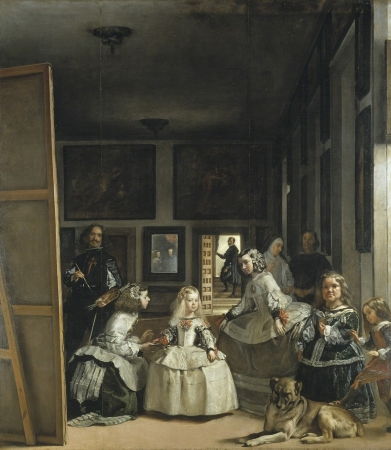
Las Meninas
This iconic painting, which translates to "Maids of Honor," presents a sumptuous scene in which the five-year-old Infanta Margarita, the heir to the Spanish throne, is surrounded by her ladies in waiting and other attendants in Velazquez's spacious painting studio. She is the daughter of King Philip IV, of whom Velazquez was court painter, and his second wife, Mariana of Austria. The large seven by ten feet painting also reveals Velazquez himself, standing behind a large canvas on the left side. The strongly foreshortened wall on the right has three rows of artwork, which help to establish the space. More than half of the space is dim, dark, and empty around the figures. The royal couple is shown as a reflection in a mirror on the back wall. Two court dwarves, and a large dog linger in the bottom right hand corner. Behind the dwarves, two women, a nun, and a lady's guard are in conversation while the queen's quartermaster is seen on the stairs at the rear in front of an open sunlit door.
Technically, the work is a testament to Velazquez's brilliance with composition. Here, he employed astute observation to create compelling portraits, but the real focus of the work, utilizing real space, mirror space, and pictorial space, is its almost modern play upon perception itself. He utilized strategic placement of his subjects to create multiple visual planes and diagonals, which draw the eye to various areas of the room in a balanced fashion. We are led not only to witness the activity in the room, but also to ponder what is outside the frames of what we can see.
Las Meninas is considered to be one of Velazquez's most famous masterpieces, representing the sum total of a career's worth of genius, intelligence, and technical mastery. It is also lauded, even 300 years later, by artists and viewers alike as a seminal example of the art of painting. Velazquez's influence lasted into the 21st century and Édouard Manet called him the "painter of painters." Picasso's 58 paintings in his series Las Meninas (1957) reinterpret the Spanish artist's work, and Dalí painted his Velázquez Painting the Infanta Margarita With the Lights and Shadows of His Own Glory (1958).
Oil on canvas - Museo Nacional del Prado, Madrid
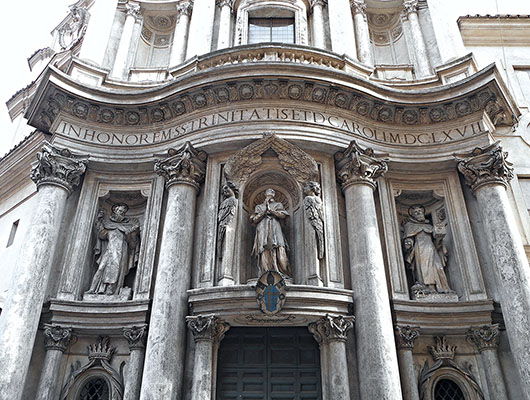
Church of San Carlo alle Quattro Fontane
This façade of the Church of San Carlo in Rome innovatively employs convex and concave bays to create an undulating effect. On the lower level, the two outer bays are concave, while the center is convex, thus emphasizing the importance of the entrance. Smaller columns frame niches filled with carved scenes and figures, creating a sense of elaborated depth. A cluster of three statues, depicting St. Charles Borromeo, patron saint of the church, and St. John of Matha and St. Felix of Valois who were also part of the Trinitarian order that Borromeo founded, preside over the central portal. Creating a contrasting vertical energy, four tall columns rise to a curved entablature, from which the four upper columns continue to another curved, but sectioned, entablature. A large oval in the center of the upper entablature, held by two angels that are asymmetrically placed, emphasizes the curvilinear flow of the structure.
Borromini's interior was equally innovative, as his plan used a complex interweaving of zones: an undulating lower zone, a middle zone in a traditional Greek cross, and an oval dome that appeared to float above the interior. Rather than depicting images, the dome had a complex but symmetrical geometric pattern that combined unequal hexagons, Greek crosses, and circles with octagonal molding. At its base, clear windows let natural sunlight into the building, and the oculus, too, was clear glass, as the light unified the space with a predominantly white interior.
The building site was challenging, as the church was located at the corner of an intersection, and had an adjoining cloister on one side that the architect also designed. Cardinal Francesco Barberini commissioned the church in 1634 and it was the architect's first major commission, though due to various financial difficulties and changes of patronage, it was not completed until after the architect's death. As art critic Olivier Bernier wrote, "based... on geometry... in the handling of form, volume and light... his buildings, although they unmistakably belong to their century, often have a startlingly modern look. Constantly playing with rounded forms - concave and convex cylinders are extensively used - Borromini gives his facades amazing animation without ever relying on mere decoration."
Marble, stone - Rome, Italy
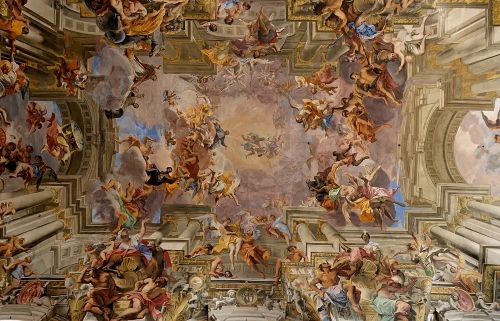
Apotheosis of Saint Ignatius
This fresco depicts the triumph of St. Ignatius, founder of the Jesuits, shown left of center in his grey cassock extending toward Christ, who holds a cross in the middle. All the light in the fresco comes from Christ, emphasized both by the golden swirling center and the gradually darkening color palette in the figures at a greater distance. The ray then breaks into four diagonal rays, representing the light of Christianity reaching the four continents of the world, and symbolizes the missionary work of the Jesuits. Also depicted are many Biblical warriors with their foes including David and Goliath, Jael and Sisera, Samson and the Philistines, and Judith and Holofernes. This innovative choice of subject matter reflected the militant Catholicism of the Counter-Reformation and the apostolic zeal of the Jesuits, seeing themselves as "warriors" for the faith.
Pozzo, a brother in the Jesuit order, said his intent was to visually embody Christ's statement, "I am come to send fire on the earth," and St. Ignatius's directive to his order, "Go and set everything aflame." The work is an innovative masterpiece of quadratura, as the viewer in the nave looking up would see a lofty dome, when in actuality the church's ceiling was flat. To achieve this effect, the artist employed extreme foreshortening, painted architectural motifs, and strict perspective, while emphasizing a dramatic swirling movement. A metal disk was placed in the floor of the nave, marking the spot where the viewer should stand to see the work with full effect, as the artist said, "To deceive the eyes, a certain fixed point" is needed.
The rich colors, swirling draperies, and excited gestures convey a feeling of a greatly impassioned crowd within a vast space. The work became a standard for ceiling paintings in Jesuit churches throughout Europe, as art historian Filippo Camerota wrote, his "perspective inventions represent the art of quadrature on its highest level. The illusory power of his fictive architecture was so strong that it forcefully conditioned the perception of space."
Fresco - Church of St. Ignatius of Loyola at Campus Martius, Rome
Beginnings of Baroque Art and Architecture
The Term: Baroque
The origin of the term Baroque is a bit ambiguous. Many scholars think it was derived from the Portuguese barrocco, meaning an imperfect or irregularly shaped pearl. And some, like the philosopher Jean-Jacques Rousseau thought it was derived from the Italian barocco, a term used to describe an obstacle in formal logic in the medieval period. In growing usage the term originally contained negative connotations, the artwork within its cadre viewed as bizarre and sometimes ostentatious. But in 1888 Heinrich Wölfflin's Renaissance und Barock (1888), the term was officially used as a simple descriptive to denote the distinct artistic style.
The Counter-Reformation

Rather than having a single moment of inception, the Baroque period brought together a number of innovative developments in the late 1500s as it was informed by the different and rival painting styles of Caravaggio, the Bolognese School led by Annibale Carracci, and the architecture of Giacomo Della Porta. A deciding factor in the formation of the movement's intensity and scope was the patronage of the Catholic Church's Counter-Reformation.
Following the 1527 Sack of Rome, and in efforts to oppose the growth of Protestantism, the Counter-Reformation sought to re-establish the Church's authority. In 1545, Pope Paul III convoked the first Council of Trent, which gathered church dignitaries and theologians to establish doctrine and to condemn contemporary heresies. The Council held 25 sessions under the leadership of Pope Paul III and his successors, Pope Julius III and Pope Pius IV, until 1563. Visual art and architecture became part of the reform campaign, as the Council established guidelines for art that included depicting religious subjects like the Immaculate Conception, the Annunciation, and the Assumption of the Virgin that were exclusive to Catholic dogma, in order to reposition the church's importance in the public eye. However, these guidelines also meant that artists could be called to task if any church official deemed their works depicting religious subjects as offensive. One of the earliest examples occurred when Venetian Renaissance painter Paolo Veronese was brought before the Inquisition to defend his Last Supper (1573), for which he was accused of including "buffoons, drunken Germans, dwarfs and other such scurrilities." When the piece was renamed The Feast in the House of Levi, alluding to a Gospel setting where sinners were present, the work was considered acceptable.

The Protestant Reformation was opposed to the use of images for religious worship, but the Counter-Reformation argued that such art had a didactic purpose and called for a new kind of visual representation that was simple but dramatic, realistic in depiction, and clear in narrative. The movement's leaders professed that art should be easily understood and strongly felt by common people with the effect of encouraging piety and an awe-inspiring sense of the church. While the church and its dignitaries had been notable art patrons since the Gothic era, a new program of patronage was intentionally spurred throughout Europe. New religious orders that were part of the reform movement like the Jesuits, the Capuchins, and the Discalced Carmelites, were officially encouraged to become important patrons of art. This new Baroque style spread throughout Europe, primarily supported by the Catholic Church led by the Pope in Rome and Catholic rulers in Italy, France, Spain, and Flanders. It was further disseminated by powerful religious orders through their extensive network of monasteries and convents.
Giacomo Della Porta
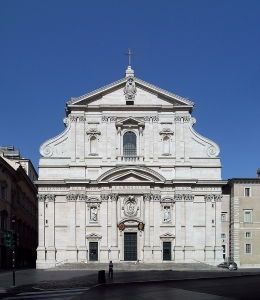
The architect Giacomo Della Porta came from a family of Italian sculptors and was a student, and later collaborator of both Michelangelo and the leading Mannerist architect in Rome, Giacomo Barozzi da Vignola. He worked with Barozzi on the building of the Church of the Gesù (1584) and, following the older man's death in 1573, completed the project with a reinterpreted design. His façade both reduced the number of architectural elements, while simultaneously clustering those elements that remained around the entrance. As a result the façade conveyed a feeling of dynamic tension that the visitor would feel before being enveloped by the vast space of the interior. Though the architect's façade was relatively simple in comparison to the much more ornate Baroque churches that followed, the church launched the Baroque style and also became the model for Jesuit churches throughout the world into the 20th century.
Bolognese School
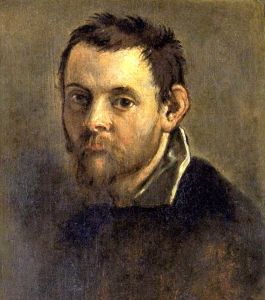
In painting, the works of the anti-Mannerist Bolognese School led by Annibale Carracci were the first to be promoted as part of the Counter-Reformation. Carracci along with his brother Agostino and Ludovico, their cousin, had launched the Accademia dei Desiderosi, a small art academy that emphasized prior Renaissance aesthetic ideals of proportion, the use of figure drawing, and precise observation to create realistic but heroic figures in emotionally compelling scenes. His work attracted the attention of the noted art patron Cardinal Odoardo Farnese who called him to Rome and commissioned him to paint the Palazzo Farnese's gallery ceiling to celebrate the wedding of the Cardinal's brother.
The resulting fresco ceiling Loves of the Gods (1597-1601) influenced the Baroque movement, as Carracci pioneered the quadro riportato technique that framed each scene as if it were an easel painting arranged on a ceiling. He also employed quadratura, or painting illusionistic architectural features, as seen in his painted figures of Atlas and classical male nudes, which resemble sculptures. The work influenced Giovanni Lanfranco, Guercino, Pietro de Cortona, Carlo Maratta, and Andrea Pozzo, all of whom became noted quadrature and trompe l'oeil ceiling painters. Carracci also had a noted influence upon future landscape and history painting as seen in the works of the French painters Claude Lorrain and Nicolas Poussin, and the French Baroque style.
Michelangelo Merisi Caravaggio
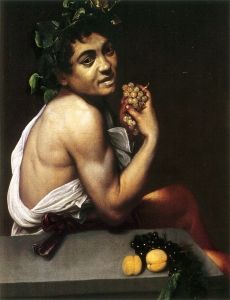
Michelangelo Merisi Caravaggio, known simply as Caravaggio, has sometimes been dubbed "the father of Baroque painting" because of his pioneering approach. Trained in Milan in the dominant Mannerist style, he quickly evolved his own technique using chiaroscuro, dramatic contrasts of light and dark, and tenebrism, intensifying the contrast into dark atmospheric scenes with some elements highly lit as if by a spotlight. His mastery of tenebrism, meaning "dark, mysterious," was such that he was often credited with inventing the technique. His radical realism, by which he painted his subjects as they actually were, flaws and all, was equally innovative and made his works controversial, as did his preference for disturbing subjects.
![Caravaggio's <i>Conversion of Saint Paul</i> (1600-1601) depicts the moment when the Roman persecutor of the Jews, struck blind by divine light, has fallen from his horse. As Helen Langdon, the artist's biographer, wrote, the painting conveys, “a sense of crisis and dislocation [as] Christ disrupts the mundane world.”](/images20/photo/photo_baroque_art_and_architecture_7.jpg)
Caravaggio became the most famous artist in Rome with his paintings of the Martyrdom of Saint Matthew (1599-1600) and the Calling of Saint Matthew (1599-1600), commissioned for the Contarelli Chapel. He was subsequently given a great number of religious commissions, though a number of them, including his Conversion of Saint Paul (1600-1601) and Death of the Virgin (1601-1606), were subsequently rejected by patrons who found his realism too shocking. Nonetheless his work became so influential that subsequent generations that adopted his style were called Caravaggisti or tenebrosi. His work influenced many great Baroque painters, including Peter Paul Rubens, Giovanni Lorenzo Bernini, Jose Ribiera, and Rembrandt van Rijn.
High Baroque
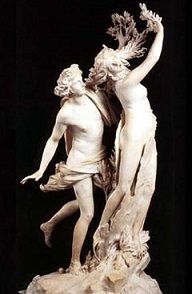
Marked by grandeur and an emphasis on movement and drama, the High Baroque began around 1625 and lasted until around 1700. Gian Lorenzo Bernini led and dominated the era, defining the Baroque style in sculpture. His patron, Cardinal Scipione Borghese, was one of the wealthiest and most powerful men in Rome, and Bernini's early sculptures were created for the Cardinal's Borghese Palace. Works like his The Rape of Proserpina (1621-22) and his Apollo and Daphne (1622-1625) emphasized dramatic realism, intense emotion, and movement, and as art historian Rudolf Wittkower wrote, they "inaugurated a new era in the history of European sculpture."
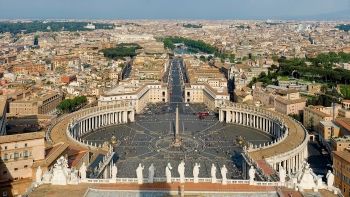
When Cardinal Scipione Borghese later became Pope Urban VIII, Bernini also became the most important architect in Rome, as seen by his being named Chief Architect of St. Peter's in 1629. His Baldachin and the colonnade he designed around St. Peter's Square (1656-1667) exemplified the High Baroque style in architecture. As art historian Maria Grazia Bernardini wrote, he was "the great, principal protagonist of Baroque art, the one who was able to create undisputed masterpieces, to interpret in an original and genial fashion the new spiritual sensibilities of the age, to give the city of Rome an entirely new face, and to unify the [artistic] language of the times."
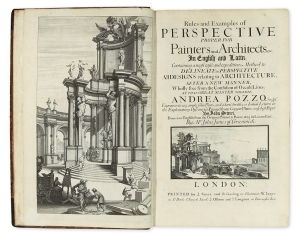
Bernini's chief rival in architecture was Francesco Borromini, whose Church of San Carlo alle Quattro Fontane (1624-1646) employed undulating walls, an oval tower, and a radically innovative oval design for the church beneath an oval dome. Ceiling painting, employing quadratura and trompe l'oeil, also became a noted feature of the High Baroque and was exemplified by Giovanni Battista Gaulli's The Triumph of the Name of Jesus in the Church of Gesù (1669-1683) and Andrea Pozzo's Apotheosis of Saint Ignatius (1688-1694), both in Rome. Pozzo also authored Perspectiva Pictorium et Architectorum (Rules and Examples of Perspective Proper for Painters and Architects). Published in two volumes, first in 1693, then 1698, it influenced artists and architects throughout Europe into the 1800s.
Baroque Art and Architecture: Concepts, Styles, and Trends
Spanish Baroque

Spanish Baroque was noted for its distinctive style, as a somber and, even sometimes, gloomy mood prevailed in Spanish culture. The Eighty Year War (1568-1648) where the Spanish sought unsuccessfully to maintain control of the Netherlands, and the Anglo-Spanish War (1585-1604) where the Spanish Armada, attempting to invade England, was defeated, drained Spanish finances and created an economic crisis. At the same time, Catholicism was informed by the severity of the Inquisition. In architecture the grandeur and wealth of the church was emphasized, as the Jesuits, an order noted for both its intellectual advocacy for the Counter-Reformation and its Christian proselytization, evolved an extreme use of ornament to accentuate religious glory. An early noted example was Pedro de la Torre's San Isidro Chapel (1642-1669), which combined an ornamented exterior with a simple interior that used light effects to convey a feeling of religious mystery. The emphasis upon Baroque decoration became even more dominant as seen in Fernando de Casa Novo's Obradoiro (1738-1750), or the façade of the Cathedral of Santiago de Compostelo. The façade became influential throughout Europe and the Spanish colonies in Latin America, as the Cathedral, a revered place of pilgrimage for centuries, was the most famous church in Spain.
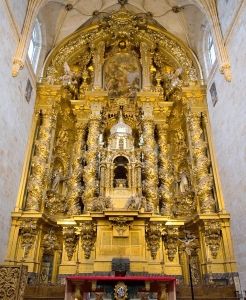
Gilded altarpieces were a noted element of Spanish Baroque architecture, as seen in José Benito Churriguer's altarpiece of Church of San Esteban in Salamanca (1693), which employed helical columns and an extensive use of gold in an extremely elaborated surface. The resulting style, emphasizing a surface in motion, was called "entallador" and was adopted throughout Spain and Latin America.
In contrast to the architectural emphasis on Catholic splendor, Spanish Baroque painting emphasized the limitations and suffering of human existence. It was noted for its focus on realism based upon precise observation and was less interested in theatrical effects than a compelling sense of human drama. Caravaggio was an early influence on artists like Francisco Ribalta and Jusepe Ribera, though most Spanish artists took chiaroscuro and tenebrism as a departure point and evolved their own style. Ribera's later work emphasized a layer of silver tones overlaid with warm golden tones as seen in his The Holy Family with St. Catherine (1648).
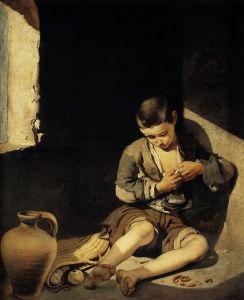
Bartolomé Esteban Murillo developed the estilo vaporiso, or vaporous style, that used a delicate palette, softened contours, and a veiling effect of silver or golden light. His works were both religious subjects like The Immaculate Conception (1678), and genre paintings, where he often depicted street people, as in The Young Beggar (1645). His work was very popular, due to its elegance and sentimentality, and he cofounded the Seville Academy of Fine Art in 1660. After his death Juan de Valdes Leal became the leading painter of Seville, though his work focused on the dramatic such as The End of Worldly Glory (1672), an allegory of death, which made his work a kind of early precursor to Romanticism. Francisco de Zurbaran was dubbed "the Spanish Caravaggio" for his religious subjects like The House of Nazareth (1630), though his compositions were more severe and restrained and often focused on a solitary ascetic figure.
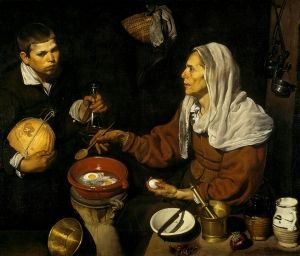
The leading painter of the Spanish Baroque was Diego Velázquez whose work included a number of subjects: genre works like Old Woman Frying Eggs (1618); historical paintings of contemporary events like The Surrender of Breda (1634-1634); religious works like Christ Crucified (1632); noted portraits like Portrait of Innocent X (1650) and Las Meninas (1656); and one of the few Spanish nudes, The Rokeby Venus (1644-1648), a subject which was discouraged in Catholic Spain. While he began by employing tenebrism, he evolved his own masterful technique, which employed a relatively simple color palette but emphasized tonalities and varied brushwork.
French Baroque and French Classicism
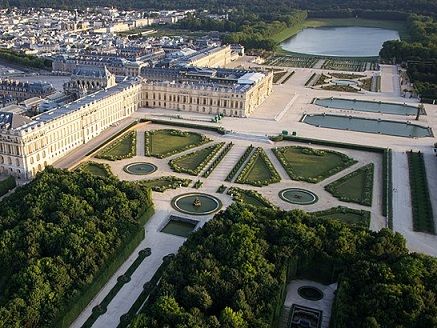
Architecture was the dominant expression of the French Baroque style. Called Classicism in France, it rejected the ornate in favor of geometric proportion and less elaborate facades. While Louis XIV invited Bernini to France to submit a design for his Palace of Versailles in 1661, the King instead chose Louis Le Vau's classical design with Charles Le Brun as decorator. As the director of the Gobelins tapestry, Le Brun's work became influential throughout Europe. The Galerie des Glaces (Hall of Mirrors) (1678-1686) at Versailles included Le Brun's paintings and became the standard for royal French interiors. Similarly the gardens, arranged in geometric grids to echo and emphasize the architecture, were another notable element of Versailles.
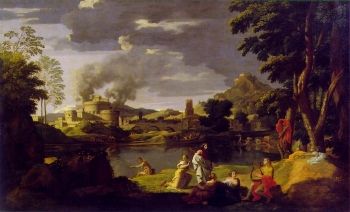
In painting, French artists also moved toward a more classical restraint. Claude Lorrain, known simply as Claude, and Nicolas Poussin, were the most important French painters, though both worked in Rome. Claude's work emphasized landscape and the effects of light, and his subjects, whether religious or classical themes, were simply the occasion of the work but not its focus. While Poussin began painting in a Baroque style, by his mid-thirties he had begun to develop his own style, as works like his Landscape with Orpheus and Eurydice (1650-1651) conveyed a calm rationality that became influential in the later development of Neoclassicism.
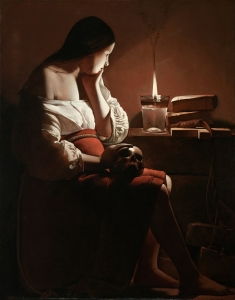
Other French artists, most notably Georges de La Tour, were influenced by Caravaggio's tenebrism but turned away from dramatic action and effects. Painting primarily religious subjects, he innovatively explored nocturnal light, employing geometric compositions and simplified forms to convey a calm and thoughtful spirituality. La Tour's work was influential in his time, as King Louis XIII, Henry II of Lorraine, and Cardinal Richelieu were patrons of his work. Genre painters like the Le Nain brothers also innovatively applied the Baroque style. Louis, Antoine, and Mathieu Le Nain collaborated on most of their works, and their genre scenes emphasized the realism of everyday labor, as seen in their The Blacksmith at His Forge (c. 1639) and Peasants' Meal (1642).
Russian Baroque
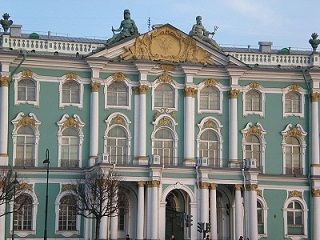
Russian Baroque is also called Petrine Baroque, named in honor of Peter the Great who promoted the style in rebuilding St. Petersburg, when he named it the new Russian capital in 1712. He had been inspired by French Baroque following his 1697-1698 visit to Versailles and the Chateaux of Fontainebleau. The Menshikov Palace (1711-1727) became a notable early example of Russian Baroque. Architects like Andreas Schluter, Gottfried Schadel, and Jean-Baptiste Alexandre Le Blond were leading architects of the style. Following Peter the Great's death, the style continued but became more luxurious and ornate as designed by the leading architect, Bartolomeo Rastrelli. The style was then called Elizabethan Baroque in honor of Empress Elizabeth Petrovona and famous examples were the Smolny Cathedral (1748-1764) and the Winter Palace (1754-1762).
Flemish Baroque Painting
Painting was the distinctive component of the Flemish Baroque, and its particular character originated in historical and cultural forces. In 1585, Spanish Catholic forces recaptured Antwerp in Flanders, or modern day Belgium, and the Catholic region was split off from the Protestant Dutch Republic. As a result, Flemish artists painted both Counter-Reformation religious subjects and landscapes, still lifes, and genre works that still drew upon the Northern European tradition.
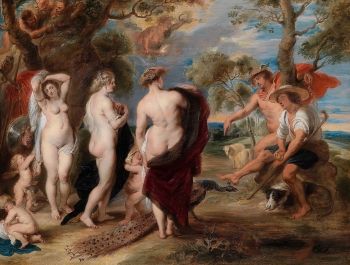
Peter Paul Rubens led the development of Flemish Baroque painting. His High Baroque style, known for its rich color, sensual exuberance, and movement informed both his religious painting as in Descent from the Cross (1614) and his non-religious subjects like the Judgment of Paris (1636). His female nudes of mythological and Biblical women were particularly renowned and influential, as they combined sensuality with a complexity of allegory and allusion. Rubens' most noted student was Anthony van Dyck who became famous later primarily for his portraits, marked by a courtly elegance. In 1630 he was appointed court painter to the Princess of Orange in 1630 and, due to royal connections, became the painter for the English court and was knighted by Charles I, the King of England, in 1632. Flemish artists also painted genre scenes, and the best known were Adriaen Brouwer, Jacob Jordaens, and David Teniers the Younger.
The Dutch Golden Age
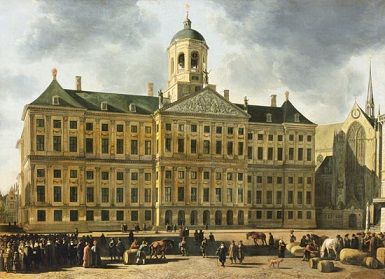
The Dutch Golden Age was the only example of the Baroque style employed in a Protestant area, and, as a result, took a very different approach in both architecture and painting. The Dutch Golden Age began around 1648 with the end of the Thirty Years War, as the Dutch Republic, which had seceded from Spain in 1588, finally achieved independence. In the decades that followed the Republic, fueled by its domination of world trade, became an economic powerhouse with a rising middle class. Dutch Baroque architecture primarily drew upon the works of the Venetian Renaissance architect Andrea Palladio (often referred to as Dutch Palladianism), while retaining some Gothic elements to create a restrained monumental style. Dutch painting emphasized scenes of everyday life, secular subjects, and pioneered developments in landscape, still life, and genre painting. Religious subjects were most often depicted in printmaking to illustrate Biblical texts. At the same time, a number of Dutch leading artists, including Rembrandt, Johannes Vermeer, and Salomon van Ruysdael painted in the Baroque style, employing chiaroscuro and tenebrism. This can be seen in Rembrandt's Night Watch (1642).
Later Developments - After Baroque Art and Architecture
The Baroque period came to an end with the emergence of Rococo in Paris around 1720. Some scholars refer to Rococo as "Late Baroque," yet it took on a very light-hearted and entertaining style bound to courtly life. Nonetheless Baroque artists continued to be influential in the Rococo period, as Rubens influenced Jean-Antoine Watteau, François Boucher, and Jean-Honoré Fragonard.
As the Rococo period was followed by the Neoclassical style within fifty years many Baroque artists became obscure and overlooked. Rubens and Rembrandt were rediscovered in the 1800s, as Rubens influenced the Romantics Théodore Géricault, and Eugène Delacroix, and Rembrandt influenced the Impressionists and Post-Impressionists. Claude's landscape paintings influenced J.M.W. Turner, and Velázquez was a significant influence upon Édouard Manet, Pablo Picasso, and Francis Bacon.
Caravaggio, too, was rediscovered, but not until the mid-1900s, and his work has subsequently influenced photographers, filmmakers, and artists. A revival of interest in Bernini's architectural work is noted by a number of contemporary architects, including I. M. Pei, Richard Meier, and Frank Gehry. Gehry called him, "one of my greatest influences." Similarly, contemporary artists including Jenny Saville, Lisa Yuskavage, and John Currin, reflect the continuing impact of the works of Rembrandt and Rubens.
Useful Resources on Baroque Art and Architecture
-
![Baroque: From St Peter's to St Paul's - Part One (Art History Documentary)]() 0 viewsBaroque: From St Peter's to St Paul's - Part One (Art History Documentary)Timeline - World History Documentaries
0 viewsBaroque: From St Peter's to St Paul's - Part One (Art History Documentary)Timeline - World History Documentaries -
![Behind the Facade - Lecture 1 - Bernini and Borromini: The rivalry, which transformed Rome]() 16k viewsBehind the Facade - Lecture 1 - Bernini and Borromini: The rivalry, which transformed Rometravsthrutime
16k viewsBehind the Facade - Lecture 1 - Bernini and Borromini: The rivalry, which transformed Rometravsthrutime
-
![Velazquez - The Painter's Painter Documentary]() 524k viewsVelazquez - The Painter's Painter Documentaryartnow
524k viewsVelazquez - The Painter's Painter Documentaryartnow -
![Diego Velázquez - National Gallery Documentary]() 226k viewsDiego Velázquez - National Gallery DocumentaryRobert Moyse
226k viewsDiego Velázquez - National Gallery DocumentaryRobert Moyse -
![Rembrandt The Power of Art]() 131k viewsRembrandt The Power of ArtOur PickSimon Schama / BBC
131k viewsRembrandt The Power of ArtOur PickSimon Schama / BBC -
![Artemisia Gentileschi Documentary]() 172k viewsArtemisia Gentileschi DocumentaryMDW
172k viewsArtemisia Gentileschi DocumentaryMDW - Bernini's Transformation of RomeOur PickMetropolitan Museum
-
![Bernini: Impresario]() 1k viewsBernini: ImpresarioTalk with Franco Mormando / CasaItalianoNYU
1k viewsBernini: ImpresarioTalk with Franco Mormando / CasaItalianoNYU -
![The Real Bernini]() 31k viewsThe Real BerniniLecture by Charles Scribner III / Metropolitan Museum
31k viewsThe Real BerniniLecture by Charles Scribner III / Metropolitan Museum -
![Bernini: Sculpting in Clay]() 27k viewsBernini: Sculpting in ClayTalk by Anthony Sigel / Metropolitan Museum
27k viewsBernini: Sculpting in ClayTalk by Anthony Sigel / Metropolitan Museum -
![Caravaggio: His life and style in three paintings]() 1.3M viewsCaravaggio: His life and style in three paintingsOur PickTalk by Letizia Treves / National Gallery
1.3M viewsCaravaggio: His life and style in three paintingsOur PickTalk by Letizia Treves / National Gallery -
![Caravaggio: An Overview]() 29k viewsCaravaggio: An OverviewLecture by Michael Fried / J. Paul Getty Museum
29k viewsCaravaggio: An OverviewLecture by Michael Fried / J. Paul Getty Museum -
![Rembrandt: The power of his self portraits | National Gallery]() 403k viewsRembrandt: The power of his self portraits | National GalleryJames Heard
403k viewsRembrandt: The power of his self portraits | National GalleryJames Heard -
![Jeremy Paxman on Rembrandt at National Gallery]() 65k viewsJeremy Paxman on Rembrandt at National Gallery
65k viewsJeremy Paxman on Rembrandt at National Gallery -
![The Loves of the Gods]() 0 viewsThe Loves of the GodsVincent Richards
0 viewsThe Loves of the GodsVincent Richards -
![Peter Paul Rubens: Painting Samson and Delilah]() 0 viewsPeter Paul Rubens: Painting Samson and DelilahJames Heard
0 viewsPeter Paul Rubens: Painting Samson and DelilahJames Heard -
![Andrew Graham-Dixon on the genius of Rubens]() 46k viewsAndrew Graham-Dixon on the genius of Rubens
46k viewsAndrew Graham-Dixon on the genius of Rubens -
![Artemisia Gentileschi: The Fortunes of a Female Painter in Baroque Italy]() 16k viewsArtemisia Gentileschi: The Fortunes of a Female Painter in Baroque ItalyOur PickLecture: Jesse Locker - Portland Art Museum
16k viewsArtemisia Gentileschi: The Fortunes of a Female Painter in Baroque ItalyOur PickLecture: Jesse Locker - Portland Art Museum
 Ask The Art Story AI
Ask The Art Story AI